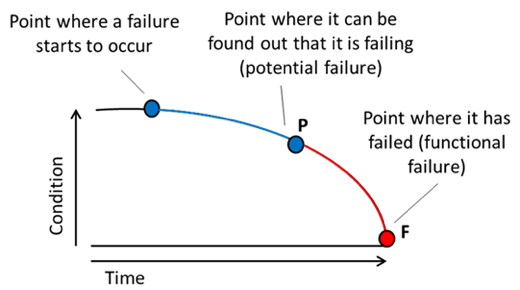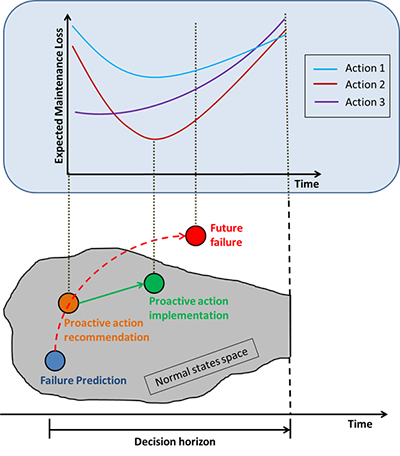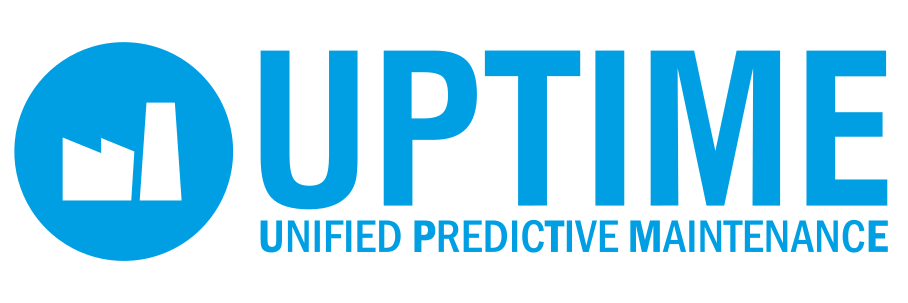UPTIME_DECIDE
Proactive Decision Making Module
On the basis of (near) real-time predictions about future failures that lay outside the “normal states space”, UPTIME_DECIDE is enacted online in order to generate proactive action recommendations, i.e. recommendations about optimal (perfect or imperfect) maintenance actions and the optimal times of proactive action implementation. To do this, it estimates when the Expected Maintenance Loss will be minimized.
UPTIME _DECIDE
• UPTIME_DECIDE provides optimal maintenance action recommendations, i.e. recommendations about optimal maintenance actions and the optimal times of proactive action implementation
• it estimates when the expected maintenance loss will be minimized
• Models the decision-making process instead of the physical manufacturing process. In this way, it is generic and applicable to various manufacturing processes
KEY ADVANTAGES OF UPTIME_DECIDE:
• Brings prescriptive analytics into predictive maintenance for facilitating proactive decision making
• Processes streams of predictions in a scalable and efficient way
• Able to recommend actions for both perfect and imperfect (of various degrees) maintenance
DECISION MAKING IN PREDICTIVE MAINTENANCE
Industry 4.0 has led to an extensive use of sensors for condition monitoring, something which facilitates decision making under time constraints.
Decision making in predictive maintenance indicates the phase which is triggered by sensor-driven, (near) real-time predictions (e.g. about a future failure mode) in order to generate proactive recommendations about maintenance actions and plans that eliminate or mitigate the impact of the predicted equipment failures.
The P-F interval, i.e. the time between the point where it can be found out that it is failing (potential failure) and the point where it has failed (functional failure), can be seen as an opportunity window during which decision making algorithms can recommend actions with the aim to eliminate the anticipated functional failure or mitigate its effect. However, the stochastic degradation process leads to high uncertainty in (near) real-time decision making.


MINIMIZE EXPECTED MAINTENANCE LOSS
The UPTIME_DECIDE component shifts decision making in predictive maintenance from early warnings into business performance optimization by eliminating or mitigating the impact of a future failure. On the basis of (near) real-time predictions about future failures that lay outside the “Normal states space”, UPTIME_DECIDE is enacted online in order to generate proactive actions recommendations, i.e. recommendations about optimal (perfect or imperfect) maintenance actions and the optimal times of proactive actions implementation. To do this, it estimates when the Expected Maintenance Loss will be minimized.
For example, for 3 alternative actions (Action 1, Action 2, Action 3), the recommendation includes the action (Action 2) and the time with the minimum expected loss. Upon user feedback, the UPTIME_DECIDE component formulates the maintenance plan.
UPTIME Other Modules :
UPTIME_SENSE serves as modular data acquisition and manipulation components of the UPTIME Platform. The SENSE component captures data from a high variety of sources and cloud environments. It can connect to both analogue and digital data sources via numerous protocols, acquire data from these heterogeneous data sources, and integrate them towards a configurable data set. It is also capable of storing and intelligently handling and filtering the data acquired and can provide it to other subsequent UPTIME components in the form of sensor data streams for further analysis and processing. Moreover, it brings configurable diagnosis capabilities on the Edge, e.g. for real-time or off-the-grid applications.
UPTIME_DETECT aims to identify the topical state/condition of technical equipment by continuously observing sensor data streams. UPTIME_PREDICT includes abnormal behaviour of technical equipment and accordingly the classification of the condition state (simple example could be traffic light indication such as green, yellow red state). This is done by the possibility to orchestrate so‐called calculation flows based on diagnosis and prediction algorithms that are already built in the algorithmic framework of the tool or that are built on purpose by implementing a simple programming interface.
UPTIME FMECA, Failure Modes Effects and Criticality Analysis, aims to assess failure impacts of a system components. The FMECA component starts from the identification of the failure modes (i.e. how something can break down or fail) associated to each system’s component of an equipment and analyse the impact of such failures on the whole system according to its physical and logical design.
UPTIME_ANALYZE is a data analytics engine driven by the need to leverage manufacturers’ legacy data and operational data related to maintenance, and to extract and correlate relevant knowledge. The ANALYZE component is designed to handle data‐at‐rest which signify data collected from various sources and physically stored across different manufacturers’ information systems.
UPTIME_VISUALIZE provides configurable visualization to save time analysing data and getting insights, to support decision making and develop new solutions.
SCIENTIFIC PUBLICATIONS
-
Prescriptive analytics: Literature review and research challenges
Lepenioti K., Bousdekis A., Apostolou D., Mentzas G. (2019) - International Journal of Information Management, vol 50, 57-70, Elsevier
-
A Unified Architecture for Proactive Maintenance in Manufacturing Enterprises
Bousdekis A., Mentzas G., Hribernik K., Lewandowski M., von Stietencron M., Thoben KD. (2019) - IN: Popplewell K., Thoben KD., Knothe T., Poler R. (eds) Enterprise Interoperability VIII. Proceedings of the I-ESA Conferences, vol 9. Springer, Cham
-
Prescriptive Analytics: A Survey of Approaches and Methods
Lepenioti K., Bousdekis A., Apostolou D., Mentzas G. (2019) - IN: Abramowicz W., Paschke A. (eds) Business Information Systems Workshops. BIS 2018. Lecture Notes in Business Information Processing, vol 339. Springer, Cham
-
A Proactive Model for Joint Maintenance and Logistics Optimization in the Frame of Industrial Internet of Things
Bousdekis A., Mentzas G. (2018) - IN: Sifaleras A., Petridis K. (eds) Operational Research in the Digital Era – ICT Challenges. Springer Proceedings in Business and Economics (pp. 23-45). Springer, Cham
-
Enabling condition-based maintenance decisions with proactive event-driven computing
Bousdekis, A., Papageorgiou, N., Magoutas, B., Apostolou, D., & Mentzas, G. (2018) - Computers in Industry, 100, 173-183
-
Information Processing for Generating Recommendations Ahead of Time in an IoT-Based Environment
Bousdekis, A., Papageorgiou, N., Magoutas, B., Apostolou, D., & Mentzas, G. (2017) -International Journal of Monitoring and Surveillance Technologies Research (IJMSTR), 5(4), 38-62
RELATED ARTICLES
UPTIME_DECIDE implementation in the FFT Transportation Logistics Business Case
UPTIME_DECIDE: Proactive Decision Making Component UPTIME_DECIDE is a component of...
Read MoreUPTIME Proactive Decision-Making Component
UPTIME Proactive Decision-Making Component : UPTIME_DECIDE A demo video showing...
Read MoreUPTIME at 12th Maintenance Forum of Hellenic Maintenance Society (HMS) in Athens
Athens, 11-12.10.2018 UPTIME at 12th Maintenance Forum of Hellenic Maintenance...
Read More